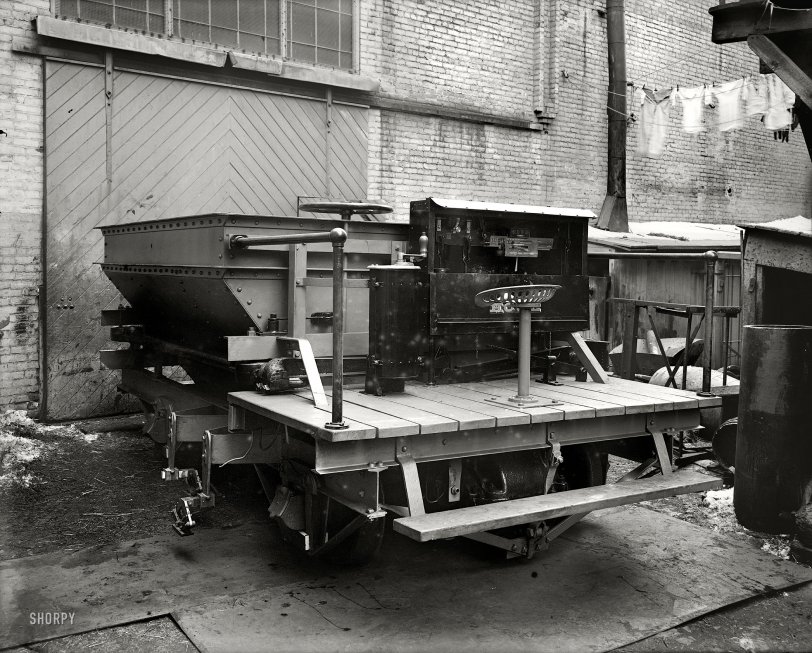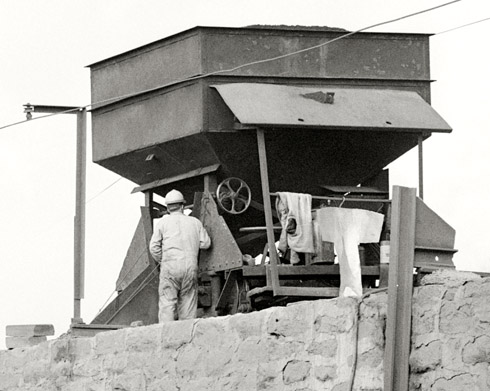


Framed or unframed, desk size to sofa size, printed by us in Arizona and Alabama since 2007. Explore now.
Shorpy is funded by you. Patreon contributors get an ad-free experience.
Learn more.

- Baldwin 62303
- Baldwin VO-1000
- Cold
- No expense spared
- Tough Guys
- Lost in Toyland
- And without gloves
- If I were a blindfolded time traveler
- Smoke Consumer Also Cooks
- Oh that stove!
- Possibly still there?
- What?!?
- $100 Reward
- Freeze Frame
- Texas Flyer wanted
- Just a Year Too Soon
- WWII -- Replacing men with women at the railroad crossing.
- Yes, Icing
- You kids drive me nuts!
- NOT An Easy Job
- I wonder
- Just add window boxes
- Icing Platform?
- Indiana Harbor Belt abides
- Freezing haze
- Corrections (for those who care)
- C&NW at Nelson
- Fallen Flags
- A dangerous job made worse
- Water Stop
Print Emporium
Machine Car: 1905

Circa 1905. "Machine car" is all it says on the jacket. It's a Howe. Can it do laundry? 8x10 inch glass negative, Detroit Publishing Company. View full size.
Foot Pedal revisited
The hopper has a mechanism to lock its movement and isolate it from the balance beam to prevent damage to, or miscalibration of, the scale. The pedal unlocks this while a measurement is being taken. Releasing it returns the hopper to its normal locked state.
Howe Center
The Old Home of Howe Scale Works, now a Center for Commercial, Industrial, Education & Business.
Still has that New Larry Car Smell
What strikes me is the cleanliness of this beast. No way it would be maintained in this condition during use. Either it was just built or just restored by staff of the Smithsonian.
Right-of-way Comes Standard
If that brute only could have been fitted with rubber tires, it might have been the least-challenged vehicle at any intersection. Imagine the respect it would have demanded of tailgaters, car door flingers and those fearless jaywalkers.
Don't give acceleration or top speed a second thought. When you're first in line with the Howe on a narrow road, you'll remain first for as long as you care to, while at your chosen rate of speed. "Crumple Zones?" It won't be you who needs them.
Simple and rugged; a real man's car, in 1905--or today. I probably would have ordered mine with a black canvas top.
Crank Handle
I'm thinking the wooden handle at driver's left is perhaps for Forward-Stop-Reverse. Anyone know whether traction engines are reversible?
Foot Pedal
Regarding the foot pedal, it's most likely a brake used during regular operation. The handbrake secures the device when not in use.
A weighty vehicle
I don't know what it is intended to weigh, but this is a self-propelled scale car. You can see the balance beam mechanism behind the "Howe" placard.
Howe Scale of Rutland, Vermont, was one of the biggest American manufacturers of commercial scales. They were bought out in 1960 by a Canadian firm, which apparently liked the trademark, as Libra Scales of Pittsburgh still uses it.
Larry Car
It's a Larry Car, a self propelled hopper car with a weigh scale to measure how much material is being loaded into a process.
Note the two third-rail shoes, traction motor on the axle, trolley car controller, operator's seat, and Howe beam scale linked by levers to the hopper supports. The offset third-rail shoes imply that they may not trust the rails to give a good ground return.
This one is about the size used to load beehive coke ovens. It loaded under a fixed hopper, and moved down the track laid above the ovens to dump into the desired oven. The ovens were buried in an earth embankment for insulation, with the loading track on top.
Much larger cars were used to transfer + weigh iron ore, coke, and limestone being loaded into blast furnaces, via the inclined skip car.
But what does it do?
Lemme see. A tractor-type seat for the operator, to its left, a streetcar type controller, and behind the seat, a Howe scale. Yes, that's a Howe scale, made in Rutland, Vermont for many years.The equipment inside the black case is very similar to the scales I've used to weigh freight cars.
Above the scale is a brakewheel. Sticking out to the lower left of the car is a skate, or third rail current collector. The closest axle is equipped with an electric traction motor.
My guess is this item was used in an industry to haul raw material around a plant. The scale was used to weigh the proper amount of stuff to be placed in the hopper.The measured material is then dumped where it will be put to use, perhaps in a steel or iron plant.
I DO know one thing. The car wasn't used here; there's no track.
Calliope
It is a homemade steam calliope. You can tell by the left handed throtlever on the framoflannis.
Details
I did some research and believe that this is what is known as a larry car. It would be used in coke (coal) production or steel. The car is designed to travel back to pick up a charge of ore or coal, carry it out to the particular dump spot, and drop it.
This one looks designed to dump out the bottom between the two axles. Ballast cars dump out the sides. This suggests not a work car but something dumping into a specific spot.
Further evidence of a larry car is the third rail pickup. Mine cars, due to miners being in and out, as well as cars in construction were either self propelled by a small steam or diesel engine; or when electric featured a trolley pole and catenary. Third rail is something you would only see used in a situation where you wouldn't have men near the rail. Making it most likely that this car was meant to work in a coke furnace type application.

Scale included!
If you look inside the box housing, there is a older weighted scale. Could this be used for something that needed relatively close weights? Like a mixture of something? Cement? Chemicals? Anyone?
I also love the clean, new third rail pickup on the side!
edit:
There is a comment posted above about the wheel above the scale being the brake. Any suggestions on what the foot pedal below the scale is for? Brake? To open the hopper and dump the load?
And yes, there is two shoe pickups for the electric supply.
Gravel Gertie
From the wheels, it would appear to be a gravel layer for railroad track beds.
Who, Howe, What
Had Mr. Howe thought to apply for a patent, Zambonis would be called Howes.
Train wheels
Well, it has train wheels and a large hopper bin so my quick guess is that it's a special car that was used to lay down gravel under the ties on train tracks.
























On Shorpy:
Today’s Top 5